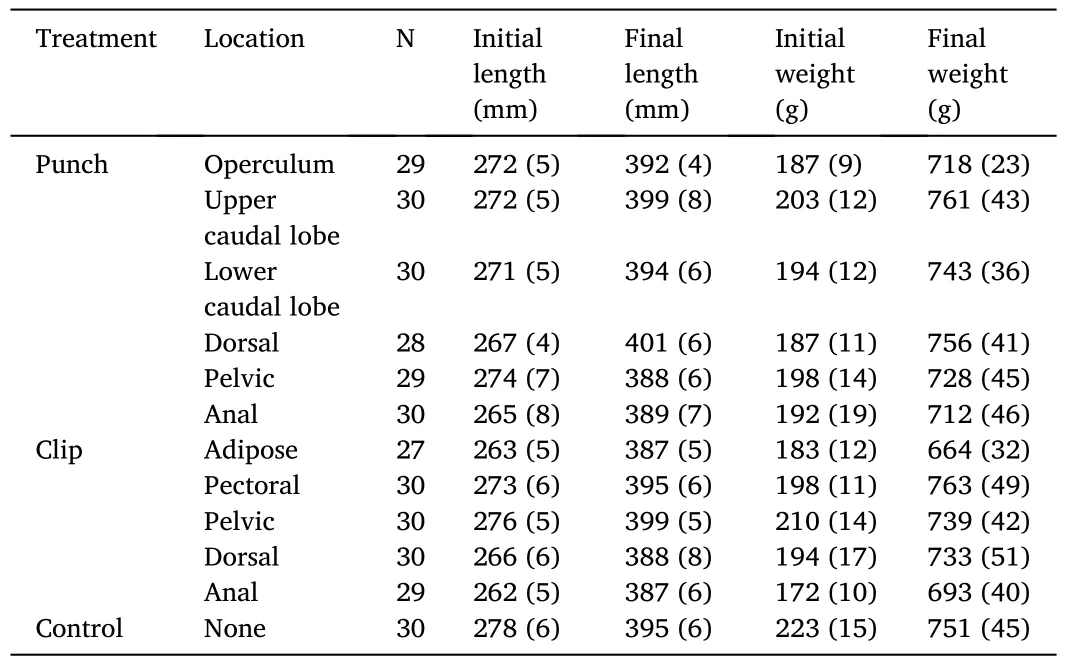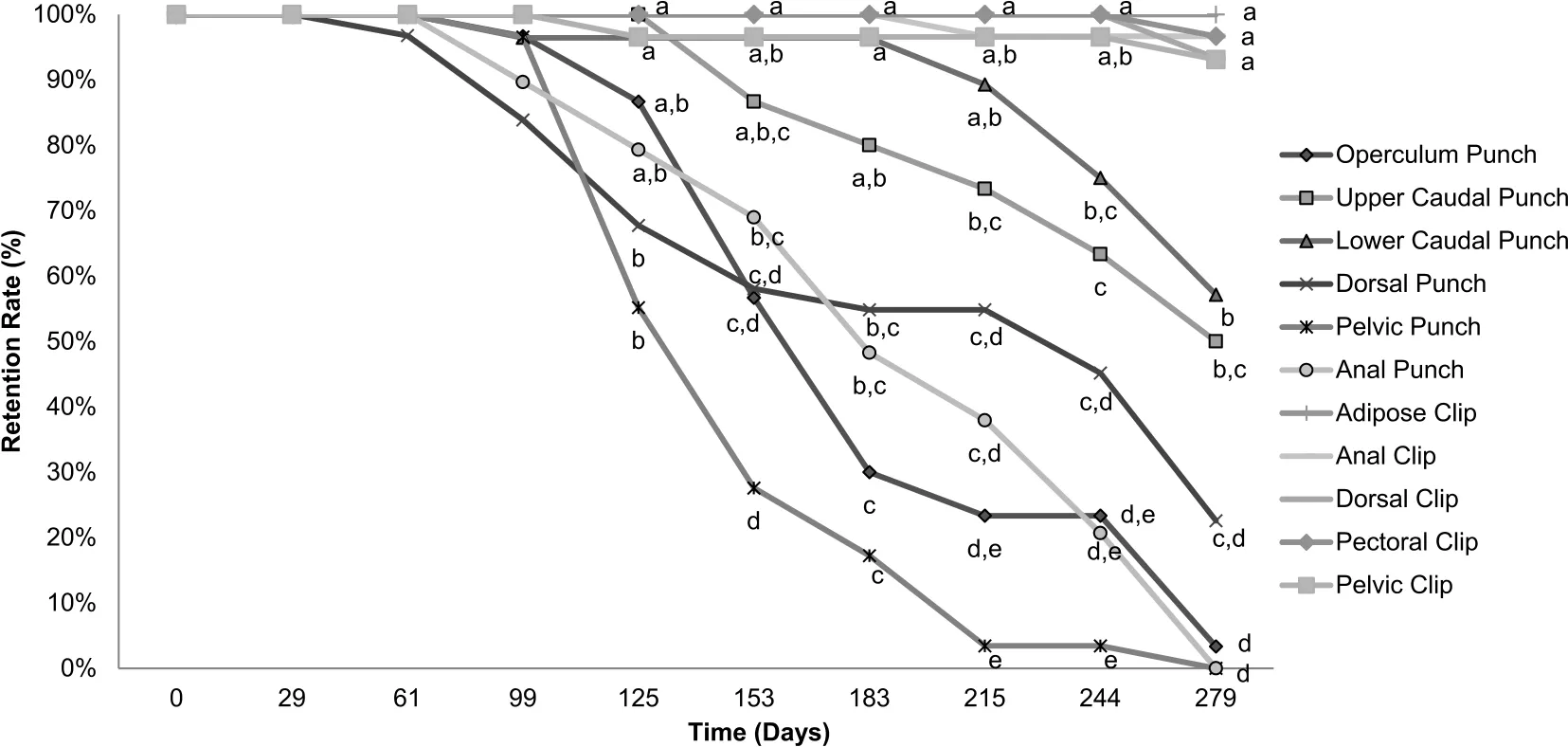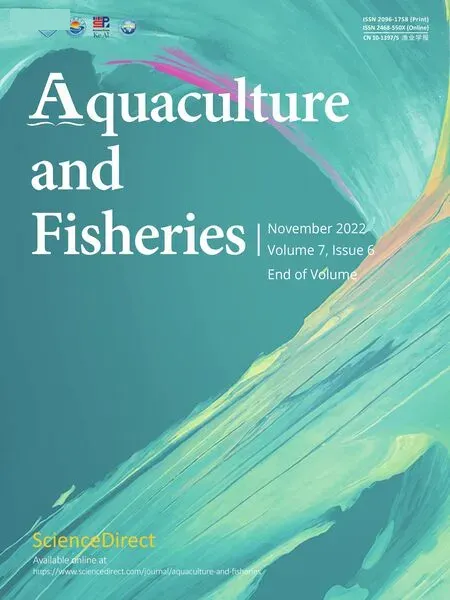Retention of fin clips and fin and operculum punch marks in rainbow trout
Alex J.Rosurg, Jao L.Davis, Mihael E.Barnes
aSouth Dakota Department of Game, Fish, and Parks, 4725 Jackson Boulevard, Rapid City, SD, 57702, USA
bSouth Dakota Department of Game, Fish, and Parks, 4130 Adventure Trail, Rapid City, SD, 57702, USA
cSouth Dakota Department of Game, Fish, and Parks, 19619 Trout Loop Spearfish, South Dakota, 57783, USA
Keywords:
Marking
Rainbow trout
Oncorhynchus mykiss
Fin punch
Fin clip
Mark retention
A B S T R A C T
Fin clips (complete fin removal) or punch marks (stamping of a hole) in fins or operculum are quick and inexpensive methods to identify individuals or groups of fish.This study evaluated the retention of 6 mm diameter punch marks on the operculum, caudal (upper and lower lobes), dorsal, pelvic, and anal fins, and fin clips on adipose, pectoral, pelvic, dorsal and anal fins of rainbow trout Oncorhynchus mykiss for 279 days.Growth and survival were not significantly different among fish with the different mark types or locations.At the end of the experiment, 100% of adipose clips, 97% of pectoral and anal fin clips, and 93% of dorsal clips and pelvic fin clips were retained.Retention of punch marks was 57% and 50% for the lower and upper caudal fin lobe locations respectively, 23% for the dorsal fin, and 3% for the operculum.No pelvic or anal fin punch marks were identified at the end of the trial.Significant differences in retention among the treatment groups did not occur until 125 days post marking, after which all fin clip treatments had significantly greater retention than pelvic and dorsal punch marks.Beyond 244 days,fin clips outperformed all punch mark locations.
1.Introduction
Careful selection of the marking location is essential for mark retention.Fins rays and tissue can regenerate, leading to under reporting of marked fish (Guy et al., 1996).Fins also differ in the rate of regeneration.In Atlantic salmonSalmo salar, clipped caudal fins were the first to regenerate, while pelvic fins showed the most regeneration over 146 days.Anal fins exhibit significantly less fin regeneration than pelvic or caudal fins but are rarely used because of increased infection risk and possibly elevated mortality (Dietrich & Cunjak, 2006).Full regeneration of fully clipped pectoral fins and half-clipped caudal fins of brown dartersEtheostoma edwinihas been reported over two months (Champagne et al.2008).In fingerling brown troutSalmo truttaL.,pectoral and anal fins exhibited the most regeneration while adipose fins regenerated the least over one year (Johnsen & Ugedal, 1988).
Few studies have examined the long-term retention of punch marks.Mark retention of 6.35 mm holes in lake troutSalvelinus namaycushcaudal fins and operculums at nine weeks was 100%.After eight months,retention was 77.5% for caudal fin punches and 77.3% of operculum punches (Allison, 1963).Additionally, opercular punch marks in common carpCyprinus carpiohave been found to be affected by fish size.Large fish (>331 mm) retained 100% of 6.4 mm punch marks up to 398 days.Small fish (<330 mm) retained 100% for 184 days, and 93% at day 328.However, retention of punch marks in small fish was 0 by day 398(Snow et al.2020).Fin punches are also used as a secondary mark in conjunction with other tagging or marking methods (Guy et al.1996).When used as a secondary mark, caudal fin punches have been reported to be identifiable from six days on Arctic graylingThymallus arcticus(Fleming & Schisler, 1993), 4.5 weeks on coho salmonOncorhynchus kisutch(Vincent-Lang et al.1993), and up to 12 weeks on lake trout(Parker & Wuttig, 2000).Operculum punches were observed up to eight weeks with Chinook salmonOncorhynchus tshawytscha(Hayes et al.2000).However, during the studies listed above, retention was not quantified prior to or during their use.The listed durations reflect the longest period these studies were able to identify a punch mark(s) but do not imply the effective duration limits of punch marks.
Historically, there has been a common belief that marking/removal of certain fins, particularly the anal fin, can lead to increased infection risk and/or cause detrimental effects on swimming performance,growth, and survival of marked fish (Nicola & Cordone, 1973; Champagne et al., 2008).A large body of literature indicates the lack of negative effects associated with fin marking/removal (Stauffer & Hansen, 1969; Mears & Hatch, 1976; Gjerde & Refstie, 1988; Zymonas &McMahon, 2006).However, one long-term study of marked and unmarked rainbow trout found removal of one or more fins led to reduced survival with fin locations differing in severity (Nicola & Cordone, 1973).
Because of the variable retention results reported for fin clips and paucity of punch retention information, this study was undertaken to improve our understanding of the effective duration for the use of punch marks and further aid in the selection of marking methods appropriate for differing applications.Using rainbow trout as a model fish species,the objectives of this study were twofold: (1) document and compare fin clip and punch mark retention on multiple fins and operculum, and (2)identify the possible effects of fin clips and punch marks on fish growth and survival.
2.Materials & methods
This study began on April 17th, 2019 and concluded on January 21,2020.All experimentation occurred at Cleghorn Springs State Fish Hatchery, Rapid City, South Dakota in a flow-through system supplied with well water (11 ℃, total hardness as CaCO3, 360 mg/L; alkalinity as CaCO3, 210 mg/L; pH, 7.6; total dissolved solids, 390 mg/L), using rainbow trout (mean total length ± SD =270 ± 31 mm).Fish were reared together in a single 6-m diameter circular tank with a cement bottom and stainless-steel walls.They were fed 4.5 mm Oncor 80,extruded,floating feed (Skretting USA, Toule, Utah) with feeding rates based on a hatchery constant using a projected growth rate of 0.05 cm/d (Butterbaugh & Willoughby, 1967).Twelve treatments were used,with 30 rainbow trout per treatment (N =30, 360 fish total) including five different fin clip and six different punch treatments.The five fin clip treatments included the removal of the adipose, pectoral, pelvic, anal, or dorsal fin, and the six punch treatments were performed through the dorsal, pelvic, anal, upper or lower caudal fin lobe, or the operculum.A control group of fish was neither clipped nor punched.
Prior to marking (clips or punches), the trout were anesthetized to stage 4 anesthesia, defined by Hikasa et al.(1986) as the cessation of reflex activity, using tricaine methanesulfonate (MS222; Argent Chemical Laboratories, Ferndale, Washington).Total lengths were then recorded to the nearest millimeter and weights to the nearest gram.Each fish next received a 12 mm passive integrated transponder (PIT) tag(HDX RFID, Oregon RFID, Portland, Oregon, USA) for individual identification throughout the study.The respective treatment,fin removal or punch, was then performed and the fish was return to fresh water for recovery.Clips consisted of complete removal of the selected fin using a scissors and punch marks were made using a 6.35 mm handheld single hole punch (Swingline, ACCO Brands, Lake Zurich, Illinois).
At each sampling date after marking, the fish were individually removed from the tank, anesthetized, measured (total length), weighed,had their PIT tag number recorded, and were assessed for all possible marks by the same evaluator throughout the study.For a visible mark,location was documented and was cross-referenced during data entry using the PIT tag ID to confirm correct mark identification.Correct identification was recorded as “retained”.Incorrect mark identifications and non-visible marks were recorded as “not retained”.Final retention estimates were based on the last date a mark was recorded as retained.Backlighting and internal viewing techniques described by Allison(1963) were used to enhance punch mark detection, particularly on the operculum.Coloration changes, including dark rings around the healed punches, also aided mark identification (Parker, 1943; Laird et al., 1975;McNicol & Noakes, 1979).Sampling occurred once per month until the end of the study at 279 days post marking.All mortality was recorded throughout the study.
Initial and final length and weight data were log transformed and analyzed using one-way analysis of variance, with significance predetermined at α =0.05.Additionally, Pearson’s chi-square tests were used to identify associations between mark retention and marking locations at each sampling event (R Core Team, 2018).The Bonferroni correction was used to account for the repeated tests performed on each sample of data (α =0.005).
3.Results
Only one fish died during the experiment and was removed prior to analysis.Additionally, 7 fish experienced tag loss/failure and were also excluded from analysis.Initial lengths (F =0.70,P=0.73), initial weights, (F =0.72,P=0.70),final lengths (F =0.82,P=0.61) and final weights (F =0.82,P=0.61) were not significantly different among the treatments (Table 1).

Table 1Mean (SE) initial lengths,final lengths, initial weights, and final weights of rainbow trout marked using punch marks,fin clips, or control (no mark) for 279 days.
There was no significant difference in mark retention rates among the treatments for the first 99 days (Fig.1).By 125 days, retention was significantly greater in the fin clip treatments compared to the pelvic and dorsal punch groups.At 215 days post-marking, retention in the adipose clip group was significantly greater than all of the punch treatment groups.At the end of the study, retention was not significantly different among the fin clip groups, at 100% (adipose), 97% (pectoral,anal), and 93% (dorsal, pelvic).Retention in all of the clip treatments was significantly greater than all of the punch treatments, with punch mark retention rates of 57% (lower caudal lobe), 50% (upper caudal lobe), 23% (dorsal), 3% (operculum), and 0 (pelvic, anal) (Champagne et al., 2008; Fulton, 1983; Galeotti et al., 2000; Guy et al., 1996; Hayes et al., 2000; Hikasa et al., 1986; Laird et al., 1975; Livings et al., 2007;Parker, 1943).

Fig.1.Percent mark retention of punch marks and fin clips used to mark rainbow trout over 279-day retention assessment.Treatments with differing letters within sampling events indicate significant differences.Significance level was predetermined at P ≤0.005 using the Bonferroni correction.
4.Discussion
The results of this study demonstrate the limited effective duration of punch marks and the preference of fin clips over punch marks beyond 244 days.Our results also support the conclusions of prior studies.At 244 days post marking, Caudal punch mark retention in the lower lobe(75%) and upper lobe (63%) are similar to the 77.5% retention rate reported in lake trout after 240 days (Allison, 1963).Conversely, in a mark recapture study of lake trout, Parker and Wuttig (2000) noted that the caudal fin punches used as secondary marks were “good for within year estimates of tag loss” and that the marks became less detectable over multiple year samplings.This contradicts our findings of 57% and 50% retention of punches located on the lower and upper caudal lobes,respectively, at 279 days post marking.The differences in these results could be due to differences in fish species, sizes, or ages.
The relatively high operculum punch mark retention rate observed in this study up to 99 days is similar to the reported 100% identification of punches used as secondary marks on Chinook salmonOncorhynchus tshawytschaup to 56 days (Hayes et al.2000).However, the 23% retention we observed at 240 days in this study is considerably less than the 77% rates reported by Allison (1963).Fish size has been shown to influence operculum punch retention and may be responsible for these disparate results (Snow et al., 2020).The high mark retention rates for all the fin clip treatments in this study is not unexpected.Livings et al.(2007) observed 100% pectoral fin clip retention in yellow perchPerca flavescensover a one-year period.Retention of 97.5% in recaptured hatchery-reared brown trout marked with adipose, pelvic, and adipose/pelvic combination fin clips after durations of 107-1639 days at sea have also been reported (Petersson et al.2014).Similarly, retention rates of greater than 95% for adipose, pectoral, and pelvic fin clips have been documented in rainbow trout after two years (Stauffer & Hansen,1969).Although clipped fins have been shown to regenerate (Johnsen &Ugedal, 1988; Dietrich & Cunjak, 2006), the duration of this study was likely too short for any regeneration to occur.
The lack of effects of fin clipping or punches on rainbow trout growth and survival in this study supports the results of Stauffer and Hansen(1969; rainbow trout), Mears and Hatch (1976; brook troutSalvelinus fontinalis), Gjerde and Refstie (1988; rainbow trout), and Zymonas and McMahon (2006; bull troutSalvelinus confluentus).However, Nicola and Cordone (1973) reported increased rainbow trout mortality after fin removal.These results were from stocked trout fingerlings in a natural lake, and mortality was only estimated based on angler data while predation was assumed to be negligible.In contrast, the present study was conducted in a controlled hatchery environment where mortality and growth were directly measured.The hatchery rearing environment used in this study could have led to fin erosion (Latremouille, 2003) and shortened or deformed operculum, both of which could have possibly affected mark retention (Osburn, 1911; Koumoundouros et al., 1997;Galeotti et al., 2000).However, neither excessive fin erosion nor severe operculum deformities were observed in this study.
5.Conclusion
All fin clips and punches used in this study are suitable for short term fish marking up to 99 days.Beyond 99 days, the location of punch marks must be considered to maximize retention, while any of the fin clips can continue to be used successfully.After 244 days, only the use of fin clips is recommended.
CRediT authorship contribution statement
Alex J.Rosburg: Conceptualization, Methodology, Investigation,Formal analysis, Visualization, Writing - original draft, Writing - review& editing.Jacob L.Davis: Conceptualization, Methodology, Formal analysis, Writing - review & editing.Michael E.Barnes: Conceptualization, Methodology, Writing - review & editing, Supervision.
Declaration of competing interest
The authors declare that they have no known competing financial interests or personal relationships that could have appeared to influence the work reported in this paper.
Acknowledgements
We thank Cody Treft, Shaylee Martling, and Cameron Enright for their assistance with rearing and data collection during the experiment.We also acknowledge the South Dakota Game, Fish, and Parks Region 1 fisheries staff for their contributions with marking and PIT tagging of study fish.
 Aquaculture and Fisheries2022年6期
Aquaculture and Fisheries2022年6期
- Aquaculture and Fisheries的其它文章
- Impact of anthropogenic activities on changes of ichthyofauna in the middle and lower Xiang River
- Comparison for ecological economic performance of Chinese sea perch(Lateolabrax Maculatus) under different aquaculture systems
- Environmental variables affecting the gillnet catches and condition of Labiobarbus festivus and Osteochilus hasseltii in northern Malaysia
- Genetic diversity and relatedness inferred from microsatellite loci as a tool for broodstock management of fine flounder Paralichthys adspersus
- Preliminary data of life history traits of Mormyridae (Actinopterygii:Teleostei) in the Upper Sanaga River, Central Region of Cameroon
- Hybrids production as a potential method to control prolific breeding in tilapia and adaptation to aquaculture climate-induced drought
